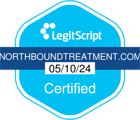Opiates fall under the umbrella of narcotic analgesics, a potent class of drugs used to treat severe or chronic pain. Opioids are also narcotic analgesics. Definitionally, opiates contain opium naturally derived from poppy plants, whereas opioids contain synthetic ingredients. That said, when people refer to either of the two, they’re usually referencing all types of narcotic painkillers.
Northbound Treatment is dedicated to supporting individuals and their families on the journey to recovery at our drug rehabilitation center. If you or someone close to you is struggling with an addiction, you may have questions about addiction treatment and the detox timeline for opiates. Read on for a detailed description of the detox process, how to detox from opiates and opioids, and the best way to go about it.
What Is Detox?
“Detox” is short for “detoxification,” and for many addicts, it’s a critical first step to achieving sobriety. Because the effects of opiates on the body can be severe, it’s crucial to detoxify the body from the drug in opiate addiction treatment. When someone stops using opiates, their body will begin getting rid of toxins associated with the narcotic — AKA detoxifying. The other component is stabilization, in which the body and brain start to relearn how to function without drugs. Detox can take an intense physical and mental toll on a person, but it’s often an essential stepping stone to rehabilitation and long-term recovery.
Why Detox Is Vital for Opiate Addiction Recovery
The detox process is particularly important for those with opiate addiction, as using the highly potent drugs can quickly lead to physical and mental dependence. Most opiates and opioids are prescribed by doctors with the intent of relieving pain due to an injury, surgical procedure, or serious illness. While many assume narcotic drug use can’t be problematic if a physician prescribes it, chemical dependence can develop rapidly and turn into drug abuse.
Types of opiate and opioid drug prescriptions include:
- Codeine
- Darvon (propoxyphene)
- Demerol (meperidine)
- Dilaudid (hydromorphone)
- Fentanyl
- Morphine
- OxyContin (oxycodone)
- Thebaine
- Vicodin (hydrocodone)
Apart from prescriptions, some individuals use pills they acquire from someone else. This is not only against the law but also considered substance abuse. Additionally, the street drug heroin is an extremely addictive opiate, and using it can result in criminal charges.
When a person becomes dependent on narcotics, they feel as if they can’t function normally without using them. Typically, this results in opiate tolerance, meaning they’ll require a higher dose to feel normal. Going without opiates for longer than a few hours will set off withdrawal symptoms, which can be exceedingly uncomfortable and challenging to deal with alone.
Opiate Withdrawal
The early symptoms of opiate withdrawal usually include anxiousness, agitation, and drug cravings. A few hours later, these feelings will heighten as the opiate addict starts to exhibit flu-like symptoms. This may include fever, body aches, sweating, chills, nausea, vomiting, or diarrhea.
After a day or two, flu-like symptoms become worse, and withdrawal reaches a peak. At this point, addicts often experience elevated heart rate, body tremors, muscle cramps, chills, hot flashes, headaches, insomnia, feelings of depression, increased irritability, and extreme cravings for opiates.
While addicts exhibit many of the same symptoms during withdrawal, your individual experience will depend partly on the nature of your addiction and the specific narcotic used. For instance, withdrawal from heroin and other short-acting opiates might be relatively brief yet more intense than long-acting drugs. Also, generally speaking, the longer a person has used and the higher the dose, the worse their withdrawal symptoms will be.
In severe cases, withdrawal symptoms may include delirium tremens (DTs), hallucinations, suicidal thoughts, seizures, hypovolemic shock, or even cardiac arrest. During withdrawal, addicts are prone to using again as a way to free themselves from the immense discomfort they’re experiencing. This is one of many reasons why the best way to detox from opiates is under medical supervision.
How to Detox from Opiates Safely
Detoxification can be miserable, and doing so alone may be dangerous. If you’re wondering how to detox from opiates safely, we can’t stress the importance of a clinical setting enough. Medically supervised detox programs are structured, safe, and secure. Clinical staff members are available 24 hours a day to support and guide patients through the stages of opiate and opioid withdrawal.
Since detox is inherently uncomfortable, many fear that a medical setting will make it worse. However, Northbound Treatment’s accredited detox program in Orange County is designed to be not only safe but also comfortable for clients. Our experienced clinicians are knowledgeable about the discomforts of withdrawal and detoxification, and they’re here to support and care for clients every step of the way.
Additionally, detoxing from opiates can lower a person’s tolerance. As withdrawal symptoms hit a peak, the urge to use again will be stronger than ever. As we mentioned, the temptation to relieve withdrawal symptoms with another dose may lead to a relapse. This is exceptionally dangerous, as a lowered tolerance could result in an overdose.
Stay Safe as You Get Sober
If left untreated, some withdrawal symptoms can be severely risky for a person’s health, and in some instances, even fatal. Vomiting, diarrhea, and excessive sweating can lead to hypovolemic shock, a life-threatening condition that occurs when 20% of a person’s bodily fluids are lost. The physical and mental anguish of opiate/opioid withdrawal can be all-consuming, which often makes people forget to stay hydrated. Healthcare providers at detox facilities monitor patients and proactively keep them hydrated to prevent the risk of hypovolemic shock.
Under clinical supervision, patients’ heart rates and other vital signs are monitored to prevent potentially fatal repercussions of delirium tremens, hallucinations, cardiac arrest, and other severe withdrawal symptoms. Not only that, but if you have a pre-existing condition, such as Hepatitis-C, tuberculosis (TB), or HIV, the detox process can put your body under immense stress. Trained clinicians are equipped to provide medical care as needed. This keeps patients safe and on track with sobriety, no matter how intense their withdrawal symptoms become.
Why Medically Supervised Detox Is Crucial
Addiction to narcotics often involves extreme highs and lows, which can take an enormous emotional toll on a person. Getting sober is a way to free yourself from this turmoil and get healthy once and for all. Of course, as most addicts are aware, quitting is easier said than done. This is why we strongly recommend a medically supervised environment. If you want to succeed in recovery and move on from your addiction, it’s the best way to detox from opiates and opioids.
Attempting to detox at home is a risk for both you and those closest to you due to the long-term effects of opiates. When withdrawal symptoms kick in, your ability to resist drug cravings will be seriously challenged. Without clinical supervision and guidance, some addicts put themselves and their loved ones in danger as they look to acquire more opiates.
Opiate Detox at Northbound
Going cold turkey and attempting at-home detox can be a dangerous choice for several reasons. If you or a loved one are ready to get clean, we encourage you to begin the path to recovery with Northbound Treatment’s detox program in Orange County. During the crucial first week of recovery, patients are closely monitored and receive immediate medical care as needed.
On top of that, we work with each client to develop a personalized treatment plan that fits their unique needs and goals. This helps them feel comfortable and be successful in their journey to sobriety, happiness, and overall well-being. Also, treatment plans are flexible and can be adjusted as needed at any point.
To say opiate and opioid detoxification is difficult would be an understatement, and we don’t want you to go through it alone. If you’re concerned about insurance coverage, please reach out to us at Northbound Treatment. We accept most major health insurance plans, many of which cover inpatient detox. Our insurance specialists can help you navigate your policy and provide you with clarity about your options.
Opiate Addiction Treatment at Northbound
Upon completion of detox, clients can move onto one of Northbound’s many rehabilitation programs. We offer residential (inpatient) rehab in Orange County, as well as outpatient services and aftercare treatment.
Addiction Treatment Programs
Depending on your individualized treatment plan, residential rehab may involve a number of different approaches, including one-on-one therapy sessions, group counseling, experiential therapy, cognitive behavioral therapy, or a 12-step program. With inpatient rehab, clients have around-the-clock support, care, and motivation.
After residential rehab, many clients transition to outpatient treatment. Northbound offers a range of outpatient options, including outpatient, intensive outpatient, and telehealth services. Each person’s path to recovery is unique. Some take the traditional steps to recovery — from detox to inpatient rehab to outpatient treatment. However, others may be better suited for intensive outpatient treatment directly after detox.
As part of Northbound’s commitment to supporting patients during every phase of recovery, we’re proud to provide opiate and opioid addiction support and aftercare services for individuals who’ve completed our rehab programs. The realities of a sober lifestyle can be alarming, and aftercare helps recovering addicts adjust and thrive.
Don’t delay opiate addiction treatment. If you or someone dear to you is struggling with substance abuse or are experiencing signs of opiate use, call Northbound Treatment today at (844) 919-0403 or fill out our online form to begin admissions.
Sources:
- “Treating Opiate Addiction, Part I: Detoxification and Maintenance – Harvard Health.” Harvard.edu. N.p., n.d., https://www.health.harvard.edu/mind-and-mood/treating-opiate-addiction-part-i-detoxification-and-maintenance
- Case-Lo, Christine. “Opioid and Opiate Withdrawal: Symptoms and Treatments.” Healthline.com. N.p., 25 Sept. 2012. , https://www.healthline.com/health/opiate-withdrawal
- Center for Substance Abuse Treatment. 4 Physical Detoxification Services for Withdrawal from Specific Substances. Substance Abuse and Mental Health Services Administration, 2006. Print., https://www.ncbi.nlm.nih.gov/books/NBK64116/











